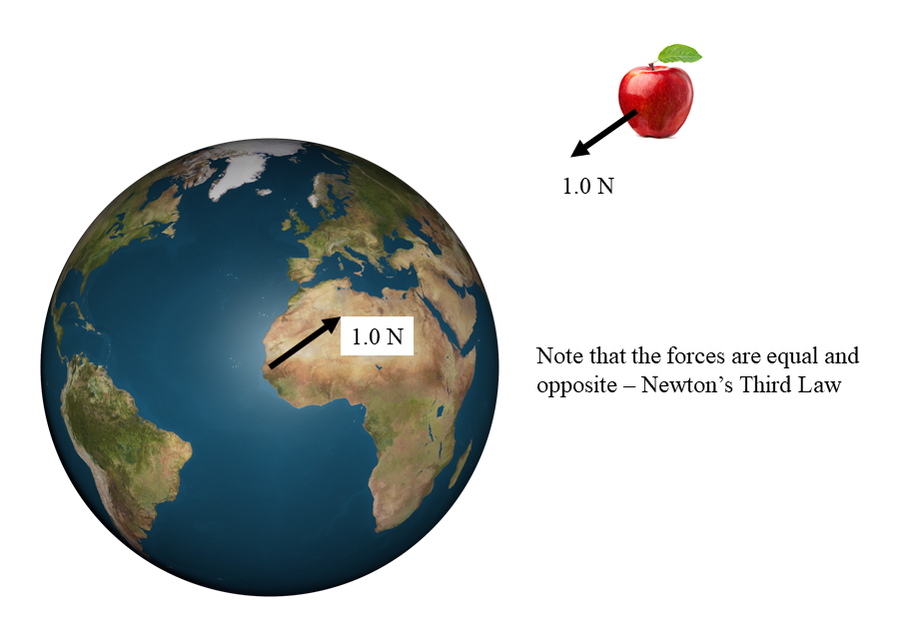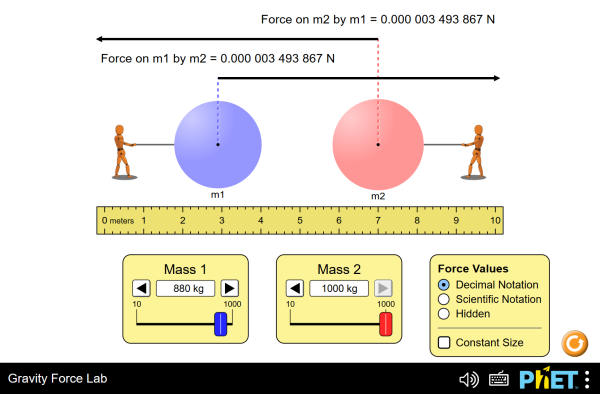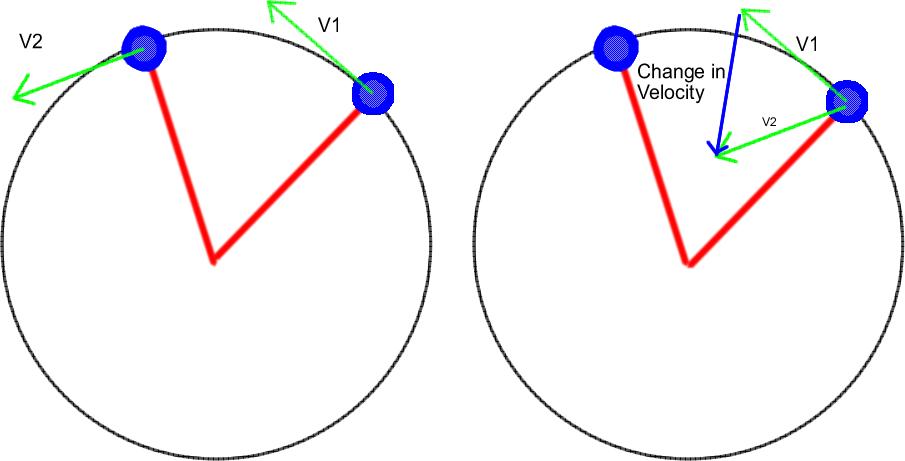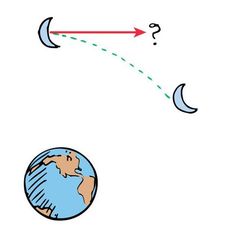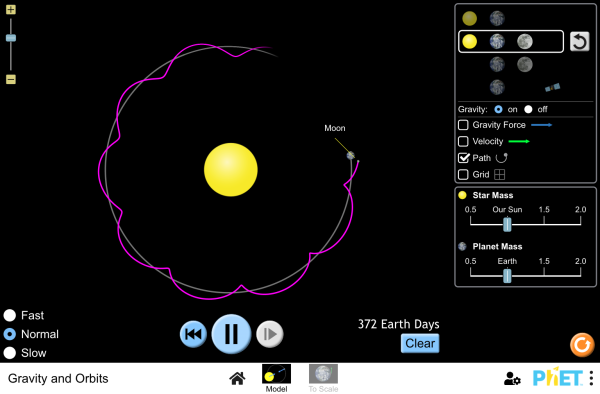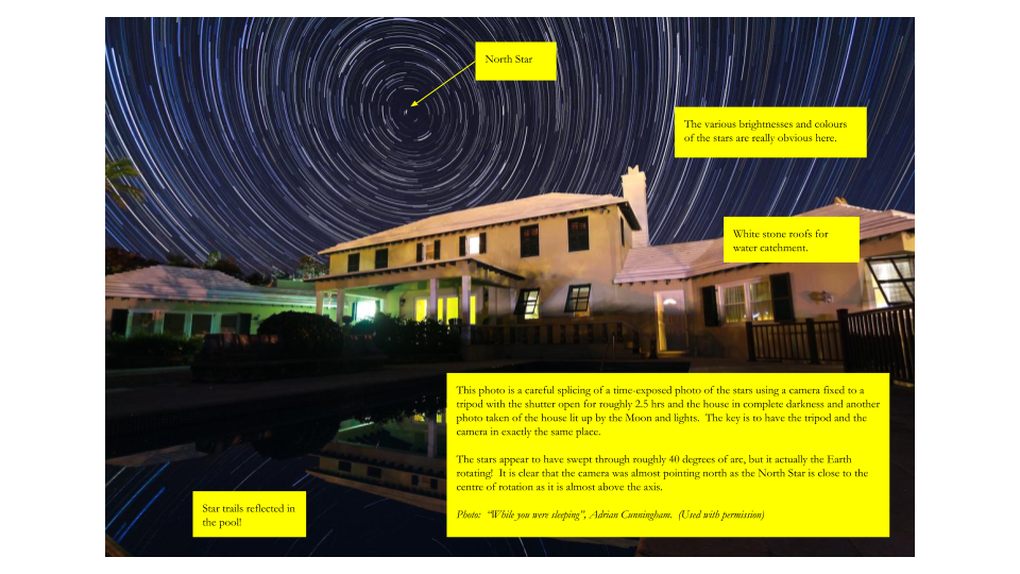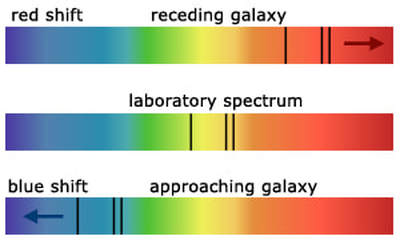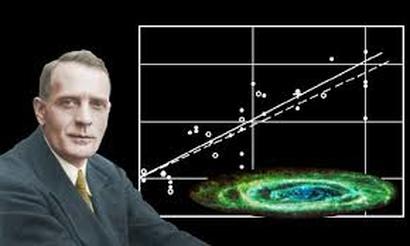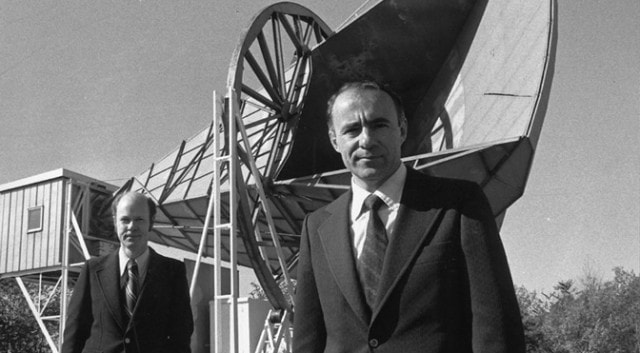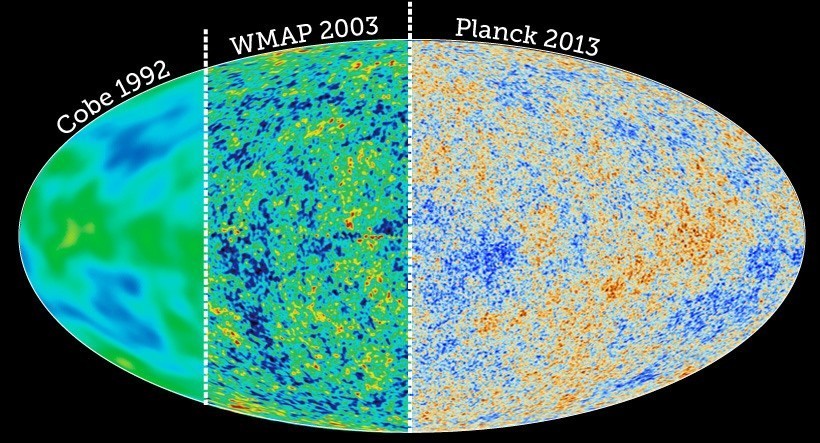|
Electricity >>
|
Photo: Star trails above a Bermuda house. Credit: Adrian Cunningham
This unit covers the concepts of gravity and how it can be used to explain the phenomenon of orbits. We also discuss the theory behind the creation and death of stars.
5.1 - Gravity
Objectives:
- Demonstrate an understanding of Newton’s third law.
- Understand gravitational field strength, g, and recall that it is different on other planets and the moon from that on the Earth.
Gravity is the dominant force in astrophysics as the masses of the objects involved are huge. What is gravity? On the most basic level, it is an attractive force that acts between any two masses. The larger the masses, the stronger the gravitational attraction is. The further apart they are from each other, the weaker the gravitational attraction. What actually causes this gravitational attraction is still unclear. Newton had no idea, Einstein theorized that masses cause the warping of space and time, but more modern ideas involve sub-atomic particles called Higg's Bosons, which have still not been conclusively found yet.... Personally, Newton's maths is the easiest to actually use and Einstein's theory makes the most sense conceptually. Newton's theory is what we use at AP level.
|
Of critical importance is to remember that the force between any two objects is a MUTUAL attraction. The forces on each object are equal and opposite. This can be hard to conceptualise at first. The force pulling an apple to the Earth is equal and opposite to that the apple pulls upwards in the Earth. If the weight of an apple is 1 N (which is the force that the Earth pulls down on it), then the upwards force on the Earth due to the apple is also 1 N. 1 N of force may accelerate an apple at 10 m/s/s, but as the Earth is vastly more massive the corresponding acceleration of the Earth is minisule.
\[a = \frac{F}{m}=\frac{1.0}{6.0\times 10^{24}} = 1.6 \times 10^{-25}\text{m/s}^{2}\] |
5.2 - Orbits
Objectives:
- Explain that gravitational force causes the planets to orbit the Sun, causes moons and artificial satellites to orbit the Earth, causes comets to orbit the Sun.
- Use the relationship between orbital speed, orbital radius and time period.
- Describe the differences in orbits of comets, moons and planets.
- Recall that the solar system is part of the milky way galaxy and that the universe is a large collection of billions of galaxies.
Newton's genius was realising that the force that pulled the apple to the ground was the same as the force required to pull the Moon into a circular path around us. A quick calculation demonstrated to him that he had cracked not only the force of gravity but explained the orbital motion of the planets and comets as well. As a side note: as his equation for gravity depends on the inverse of the square of the distance, theoretically gravity extends an infinite distance, although very weakly. In one stroke Newton had expanded mankind's concept of the Universe to infinity and beyond. The idea that the Solar System was enclosed in a black shell perforated by holes through which we could see heaven was instantly blown out of the water.
Why do things move in a circle? From Newton's First Law we know that if not subjected to a force an object will continue to move in a straight line at a constant velocity. If there is a force acting forwards, it accelerates. If it acts behind, it decelerates. However, if it acts at precisely 90 degrees, the speed of the object does not change, but its direction does. If this force is maintained always to be perpendicular to the velocity of the object, it will be forced to move in a circle at constant speed. Whirling a ball on a string around your head is an example. If the string breaks, the ball will fly off at a tangent to the circle as it is no longer constrained into a circle.
Why do things move in a circle? From Newton's First Law we know that if not subjected to a force an object will continue to move in a straight line at a constant velocity. If there is a force acting forwards, it accelerates. If it acts behind, it decelerates. However, if it acts at precisely 90 degrees, the speed of the object does not change, but its direction does. If this force is maintained always to be perpendicular to the velocity of the object, it will be forced to move in a circle at constant speed. Whirling a ball on a string around your head is an example. If the string breaks, the ball will fly off at a tangent to the circle as it is no longer constrained into a circle.
It is important to realise that if the Moon stopped moving it would fall towards the Earth! Luckily as there is no air resistance that far into space, it will not slow down and we are safe. If gravity were to be suddenly switched off - the Moon would leave orbit at a tangent as there would be nothing to force it to change direction. (Of course, if gravity were to be switched off, we would have enough problems of our own and would not care about the Moon too much...)
As the planets are all different distances from the Sun, they experience a different amount of the Sun's gravitational force. Mercury is the closest and has the greatest force acting on it, while Pluto has by far the weakest. Pluto orbits at a slower speed than Mercury. The time the planets take to go around the Sun (their Period, T) depends on two factors: their speed and the distance they need to travel.
5.3 - Stars
Objectives:
- Understand how stars can be classified according to their colour.
- Know that a star’s colour is related to its surface temperature
- Describe the evolution of stars of similar mass to the Sun through the following stages: nebula, star (main sequence), red giant, white dwarf.
- Describe the evolution of stars with a mass larger than the Sun
- Understand how the brightness of a star at a standard distance can be represented using absolute magnitude
- Draw the main components of the Hertzsprung–Russell diagram
If you look carefully at the star trail photo at the top of this page you will notice three things:
- The angles of the arcs are all the same. This is due to the length of time that the shutter of the camera was open and the spin of the Earth. The star at the centre of the curves is the North Star, which is also known by its latin name, Polaris. The angle between the North Star and the horizon will be the same as the latitude. In Bermuda this is 32 degrees. If you are facing towards the North Star, you are facing north. It is not a particularly bright star, it just happens to be located above the Earth's axis of rotation.
- The colours of the stars are different. This is due to varying surface temperatures of the stars. Red is relatively cool, blue is very hot.
- The brightness of the stars are different. This can be due to either distance from the Earth or size of the star. The larger a star, the more light is emits from its surface, therefore the brighter it is. The closer a star is to us, the brighter it looks. Not surprisingly, it is not easy to measure the distances to stars.
|
|
|
|
|
|
|
|
|
5.4 - Cosmology
Objectives:
- Describe the past evolution of the universe and the main arguments in favour of the Big Bang.
- Describe evidence that supports the Big Bang theory (red-shift and cosmic microwave background radiation).
- Describe that if a wave source is moving relative to an observer there will be a change in the observed frequency and wavelength.
- Be able to use the equation relating the speed of light to the speed of a receding galaxy.
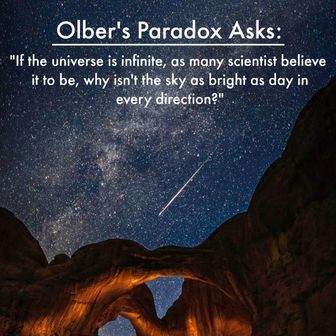
When Isaac Newton discovered the inverse-square law of gravity he literally changed mankind's view of the universe. As an inverse square has no end point, the universe suddenly became infinite. This was mind-blowing at the time, and in a way still is. Previous to that it was believed that the universe was not much larger than our Solar System and was surrounded by heaven.
Infinities produce problems.
The most famous of which was known as Olber's Paradox. If the universe was infinite and unchanging, then why is the night sky black? The solution to this puzzle was with two discoveries:
1. The speed of light is fast (300,000 km/s) but finite.
2. The universe is not unchanging and had a beginning.
The consequence of the finite speed of light is that when you look at a star, you are seeing it how it was when the light left it, and it takes time to reach your eye. In effect you are looking backwards in time. The further the star is away, the further back in time it is. For example, when we look at the Sun, we are looking back some 8 mins ago, the nearest star is Proxima Centauri, which is some 4.2 light years away, so we see it as it was 4.2 years ago. When we consider the black between the stars, we are looking so far back in time that the stars weren't born yet. Have fun with that one on a dark night....!
At the beginning of the 20th century an American astronomer called Edwin Hubble started to get interested in the Messier objects - fuzzy blobs that looked like stars. With the more powerful telescopes he discovered that they were in fact huge cities of stars - billions of them. The universe got even bigger! The deeper into space he looked, the more galaxies he found. A few years later, he spotted that the light emitted from the stars of these galaxies was shifted slightly towards the red end of the visible light spectrum. He realised that this 'red shift' was caused by the Doppler Effect. The Doppler Effect is common on Earth and occurs whenever a wave is being emitted from an object that have a relative speed to an observer. The most common example is when a police car goes past with a siren on. As the car approaches you the pitch of the siren appears to increase as the siren catches up with the wave that it is producing. As it moves past and away, the opposite is observed. The pitch decreases as the siren moves away from the wave. Hubble realised that the red shift was caused by the galaxies moving away from us. By measuring the distance and the speed that they galaxies were receding he discovered Hubble's Law. The speed of recession is directly proportional to the distance away from us. NO galaxies are moving towards us. But this does not mean that a) the galaxies have big rocket engines or that b) we are the centre of the universe. It means that the fabric of the universe, which the galaxies are part of, is expanding. Even more stunning, the universe must have had a beginning. By a bit of simple maths based on his data Hubble calculated that the universe is some 13-15 billion years old.
Based on this notion of the universe exploding into being and expanding came the popular name - the Big Bang.
Infinities produce problems.
The most famous of which was known as Olber's Paradox. If the universe was infinite and unchanging, then why is the night sky black? The solution to this puzzle was with two discoveries:
1. The speed of light is fast (300,000 km/s) but finite.
2. The universe is not unchanging and had a beginning.
The consequence of the finite speed of light is that when you look at a star, you are seeing it how it was when the light left it, and it takes time to reach your eye. In effect you are looking backwards in time. The further the star is away, the further back in time it is. For example, when we look at the Sun, we are looking back some 8 mins ago, the nearest star is Proxima Centauri, which is some 4.2 light years away, so we see it as it was 4.2 years ago. When we consider the black between the stars, we are looking so far back in time that the stars weren't born yet. Have fun with that one on a dark night....!
At the beginning of the 20th century an American astronomer called Edwin Hubble started to get interested in the Messier objects - fuzzy blobs that looked like stars. With the more powerful telescopes he discovered that they were in fact huge cities of stars - billions of them. The universe got even bigger! The deeper into space he looked, the more galaxies he found. A few years later, he spotted that the light emitted from the stars of these galaxies was shifted slightly towards the red end of the visible light spectrum. He realised that this 'red shift' was caused by the Doppler Effect. The Doppler Effect is common on Earth and occurs whenever a wave is being emitted from an object that have a relative speed to an observer. The most common example is when a police car goes past with a siren on. As the car approaches you the pitch of the siren appears to increase as the siren catches up with the wave that it is producing. As it moves past and away, the opposite is observed. The pitch decreases as the siren moves away from the wave. Hubble realised that the red shift was caused by the galaxies moving away from us. By measuring the distance and the speed that they galaxies were receding he discovered Hubble's Law. The speed of recession is directly proportional to the distance away from us. NO galaxies are moving towards us. But this does not mean that a) the galaxies have big rocket engines or that b) we are the centre of the universe. It means that the fabric of the universe, which the galaxies are part of, is expanding. Even more stunning, the universe must have had a beginning. By a bit of simple maths based on his data Hubble calculated that the universe is some 13-15 billion years old.
Based on this notion of the universe exploding into being and expanding came the popular name - the Big Bang.
Exam bit - to calculate the recessional velocity of a galaxy, we can use the following equation:
\[v=\left ( \frac{\Delta\lambda}{\lambda} \right )c\]
\[v=\left ( \frac{\Delta\lambda}{\lambda} \right )c\]
In 1964 Penzias and Wilson discovered (almost by accident) the second major piece of supporting evidence of the Big Bang - an afterglow. This is known as the Cosmic Microwave Background. An explosion of an infinitely hot, infinity dense universe implies that as time progresses the universe must cool down as it expands. A very hot object, such as a star, emits EM radiation in the form of visible light. As it cools down the frequency of that light reduces, as its energy decreases, to a dull red, to the infrared (IR) of our everyday lives. Cool down further and this EM radiation starts to be in the microwave section of the EM spectrum. Measuring the frequency of this radiation will give you the temperature of the source - this is how IR cameras and thermometers work. Penzias and Wilson discovered that no matter where in the sky they pointed their detector, they recorded the temperature of the universe as a chilly, but crucially not zero, 2.7 K.
One way to look at it is - if you walked into a cave and noticed embers on the ground and warmth in the air, you would quickly deduce that there had been a fire in the past. The elements are the embers and the warm air is the Cosmic Microwave Background Radiation.
One way to look at it is - if you walked into a cave and noticed embers on the ground and warmth in the air, you would quickly deduce that there had been a fire in the past. The elements are the embers and the warm air is the Cosmic Microwave Background Radiation.
Electricity >>
Other Resources
BBC News - Flying to Mars (career move?) Dr Alibay came to Bermuda over the spring 2018 and gave a series of talks. Fascinating stuff, makes me wish that I had studied harder at university!
Guardian - article about the photo of the 1919 solar eclipse that demonstrated that Einstein's theory of general relativity could bend light.
